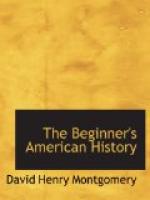[Illustration: Map showing how much of the continent of North America was discovered by the Cabots.]
The English now began to see what an immense extent of land they had found beyond the Atlantic. They could not tell, however, whether it was a continent by itself or a part of Asia. Like everybody in Europe, they called it the New World, but all that name really meant then was simply the New Lands across the sea.
[Footnote 9: Labrador (Lab’ra-dor).]
26. How the New World came to be called America.—But not many years after this the New World received the name by which we now call it. An Italian navigator whose first name was Amerigo[10] made a voyage to it after it had been discovered by Columbus and the Cabots. He wrote an account of what he saw, and as this was the first printed description of the continent, it was named from him, America.
[Footnote 10: Amerigo (A-ma-ree’go): his full name was Amerigo Vespucci (A-ma-ree’go Ves-poot’chee), or, as he wrote it in Latin, Americus Vespucius.]
27. Summary.—In 1497 John Cabot and his son, from Bristol, England, discovered the mainland or continent of North America, and took possession of it for England. The next year they came over and sailed along the eastern coast of what is now the United States.
An Italian whose first name was Amerigo visited the New World afterward and wrote the first account of the mainland which was printed. For this reason the whole continent was named after him, America.
Who was John Cabot? What did he try to do? Who sailed with him? What land did they see? Had Columbus ever seen it? What did Cabot do when he went on shore? What is said of his return to Bristol? What did the Cabots carry back to England? What is said about the second voyage of the Cabots? How did the New World come to be called America?
Ponce de Leon,[1] Balboa,[2] and
de Soto[3]
(Period of Discovery, 1513-1542).
28. The magic fountain; Ponce de Leon discovers Florida; Balboa discovers the Pacific Ocean.—The Indians on the West India Islands believed that there was a wonderful fountain in a land to the west of them. They said that if an old man should bathe in its waters, they would make him a boy again. Ponce de Leon, a Spanish soldier who was getting gray and wrinkled, set out to find this magic fountain, for he thought that there was more fun in being a boy than in growing old.




